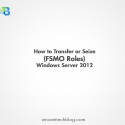FSMO roles are the Flexible Single Master Operation Roles of Active Directory which consist of the following five roles in two categories
Forest Wide Roles
1. Schema master: The Schema Master FSMO role owner is the DC responsible for performing updates to the directory schema. This DC is the only one that can process updates to the directory schema.
2. Domain naming master: The Domain Naming Master FSMO role owner is the DC responsible for making changes to the forest-wide domain name space of the directory in the Partitions container. This DC is the only one that can add or remove a domain or application from the directory.
Domain Wide Roles
3. RID master: The RID Master FSMO role owner is the single DC responsible for processing RID pool requests from all DCs within a given domain. It is also responsible for moving an object from one domain to another during an inter domain object move.
4. PDC emulator: The PDC emulator master acts in place of the PDC if there are WindowsNT 4.0 domain controllers (BDCs) remaining within the domain, acting as a source for them to replicate from. The PDC emulator master receives preferential replication of password changes within the domain.
5. Infrastructure master: The infrastructure FSMO keeps its domain’s references to objects in other domains up-to-date by comparing its data with information in the Global Catalog (GC).
As a system administrator it very important to plan the storage of this Roles properly after building your domain. Read full article on Active Directory FSMO on Microsoft’s Blog HERE
However, very important task is to know how to manipulate the FSMO Roles after understanding them theoretically.
The video below shows how to transfer the FSMO roles between servers both on the Graphical User Interface and the Command Line Interface. And it also talks about seizing of the FSMO roles.
Watch FSRM Roles video tutorial below
![]()


Leave a Reply